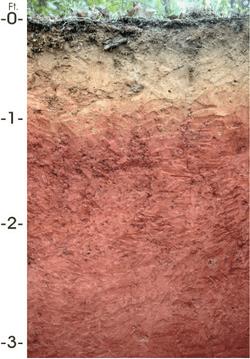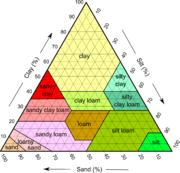loam
English

Three layers of subsurface loam; surface layer is dark brown fine sandy loam, subsurface layer is pale brown fine sandy loam, subsoil is red clay loam and sandy clay loam.

Soil types by clay, silt and sand composition as used by the United States Department of Agriculture
Etymology
From Old English lām.
Noun
loam (countable and uncountable, plural loams)
- (geology) A type of soil; an earthy mixture of sand, silt and clay, with organic matter to which its fertility is chiefly due.
- 1602 : William Shakespeare, Hamlet, act V scene 1
- Alexander died, Alexander was buried, Alexander
- returneth to dust, the dust is earth, of earth we make
- loam, and of why that loam whereto he was converted
- might they not stop a beer-barrel?
- 1602 : William Shakespeare, Hamlet, act V scene 1
- (metalworking) A mixture of sand, clay, and other materials, used in making moulds for large castings, often without a pattern.
Derived terms
Translations
type of soil
mixture for making moulds
|
|
Verb
loam (third-person singular simple present loams, present participle loaming, simple past and past participle loamed)
- To cover, smear, or fill with loam.
Part or all of this entry has been imported from the 1913 edition of Webster’s Dictionary, which is now free of copyright and hence in the public domain. The imported definitions may be significantly out of date, and any more recent senses may be completely missing.
(See the entry for loam in Webster’s Revised Unabridged Dictionary, G. & C. Merriam, 1913.)
Translations
to cover or fill with loam
|
|
Derived terms
- loamer
Adjective
loam (not comparable)
- Made of loam; consisting of loam.
This article is issued from
Wiktionary.
The text is licensed under Creative
Commons - Attribution - Sharealike.
Additional terms may apply for the media files.